
Stony Brook University Vibrational Spectroscopy Laboratory
Research Activities
If you are looking for published spectra and optical constants, please go here.
Current Projects
Lunar Mineralogy from LRO Diviner
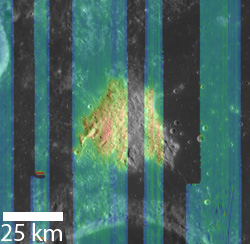
The Diviner Lunar Radiometer on board the Lunar Reconnaissance Orbiter spacecraft includes three narrow-band channels near 8 μm designed to allow us to estimate the position of the silcate Christiansen feature, which is indicative of mineralogy. Using this instrument we have identified highly silicic features on the Moon, including likely volcanic edifices (see Figure to the left). Other group members are utilizing Diviner search for olivine-rich terrains on the Moon and refine estimates of surface mineralogy by combining data from Diviner and the Moon Mineralogy Mapper .
Martian Salts
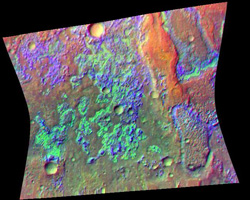
We are using THEMIS and CRISM data to characterize putative chloride salt deposits on the surface of Mars. A major focus of the investigation is determining the effects of atmospheric conditions and the surface mineralogy and physical properties on the VNIR and TIR spectra of chloride-bearing surfaces. We are also performing laboratory experiments at both VNIR and TIR wavelengths in an effort to determine the abundance of chloride salts on the Martian surface. The CRISM image to the left shows a portion of the Terra Sirenum region of Mars, where salts and clay minerals are often detected in close proximity to one another. In this false-color representation, clays appear blue and salts appear green.
Clay Dehydration and Dehydroxylation
Phyllosilicates on Mars are distributed primarily on ancient, heavily cratered, Noachian terrains. We have been investigating the effects of shock heating on the infrared spectra of phyllosilicates in an effort to determine how impact processes may have altered phyllosilicates present in the Martian crust. Using equipment available in the Vibrational Spectrosocpy Laboratory, we have acquired TIR reflectance and emissivity, attenuated total reflectance (ATR) and VNIR reflectance of 16 phyllosilicate and zeolite samples heated to temperatures between 100 and 900 degrees C. A recently funded project (Dr. Joseph Michalski, PI) will allow us to acquire infrared and Raman spectra from samples that have been experimentally shocked at Johnson Space Center's Flat Plate Accelerator facility.
Mid-IR Optical Constants of Low-Symmetry Minerals
We have developed a Lorentz-Lorenz dispersion theory model to determine the orientation-dependent optical constants of monoclinic minerals. At this early stage of the project, we are focusing our efforts on determining the real and imaginary indices of refraction (n and k) for minerals that are common on planetary surfaces, including feldspars and clinopyroxenes. We are also working on developing a model and experimental methods for derivation of optical constants of triclinic minerals. As spectra, optical constants, and oscillator parameters are published in the literature, they will be made available at http://aram.ess.sunysb.edu/tglotch/spectra.html
Calculation of the Scattering Properties of Particulates
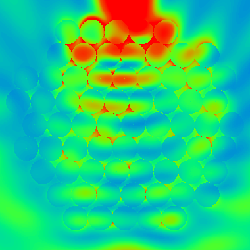
We are using the publicly available Multiple Sphere T-Maxrix Model to exactly calculate the scattering properties of clusters of spheres of different compositions. These calculations, which exactly solve Maxwell's equations at every wave/particle interface, are computationally intensive, requiring the use of the New York Blue and NASA Pleiades supercomputers. Our first projects using this model include efforts to calculate the midr-IR emissivity spectra of quartz powders of various grain sizes as well as the mid-IR emissivity spectra of salt-silicate mixtures, which may help us understand the compositions Martian chloride salt depoits and the surfaces of Trojan asteroids. The figure above shows the E-field magnitude where an incident IR beam is interacting with a cluster of salt and olivine particles. The beam, which is coming from below the cluster, does not have a strong interaction with the transparent salt particles. Near the top of the cluster, the beam interacts with an olivine particle, resulting in strong scattering.
Micro-FTIR and Micro-Raman Spectroscopy of Shocked Basalts
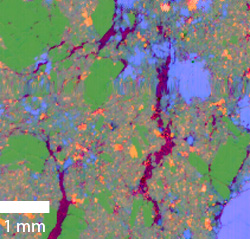

We have acquired a suite of shocked and unshocked basalts from Lonar Crater, India, provided by Dr. Shawn P. Wright at the University of New Mexico. Our goal with this project is to understand the micro-scale changes that occur to both weathered and unweathered protoliths when they are exposed to shock pressures ranging from 20-80 GPa. The formation of maskelynite (glass with a plagioclase feldspar composition) is a key indicator of moderate shock pressures. The image in the upper left is a decorrelation stretched (DCS) infrared image of a shocked basalt. All plagioclase feldspar in this sample has been replaced by maskelynite (green) while pyroxenes (orange) are left unchanged. Glass additionally forms from the quenching of melted rock in pockets and veins (blue and purple). We can use our Raman imaging capabilities to look at mineralogical differences at finer spatial scales (< 1 micron). The Raman image in the upper right shows distributions of titanomagnetite, pyroxene, and plagioclase in an unshocked basalt from Lonar crater.
Thermal Emission Spectroscopy of Altered Basalts from Mauna Iki, Hawaii
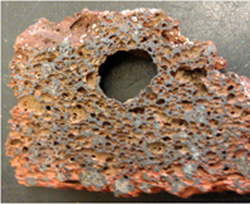

As part of a project led by Dr. Jacob Bleacher at NASA's Goddard Spaceflight Center, we have acquired a suite of basaltic rocks from the Mauna Iki lava flow on Hawaii Kilauea volcano. The goals of this project are to acquire infrared spectra of weathered and unweathered samples (see above) to determine the mineralogy of both pristine and chemically altered surfaces. The results of this laboratory work, when compared to spacecraft and airborne remote sensing data, will help to develop strategies for human exploration based on remotely acquired infrared spectra.